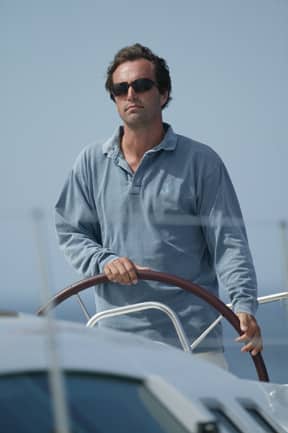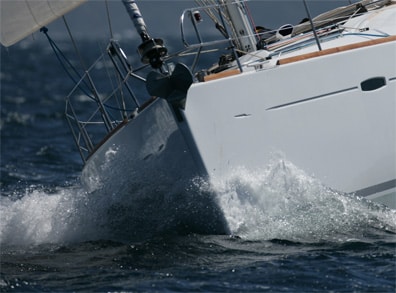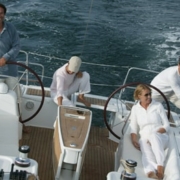Good Captainship
Being a good captain on a bareboat charter is a real skill. It is very unlike being a good captain on a military or commercial ship or even a captain in a local yacht race. The biggest reason is that not only are you on vacation, but EVERYONE ELSE IS ALSO ON VACATION. So you’re there to ensure that they have a fantastic time. That they will come back and that they will come back with you.
 So we’ll cover a few rudimentary leadership skills that will help you and everyone enjoy their vacation.
So we’ll cover a few rudimentary leadership skills that will help you and everyone enjoy their vacation.
When people are led by good captains they do not even remember that they were lead. That means they just remember that the vacation went off without a hitch and the boat seemed to work itself, yet somehow, everyone contributed.
Good leaders make people feel comfortable in any environment. Your confidence and promotion of a good time for everyone will help people feel comfortable throughout the trip.
Obviously, as everyone will tell you, your job #1 is to ensure the safety of the ship and crew, however following closely behind that comes the job to ensure that everyone onboard is feeling comfortable with you and the vessel. So let me shout this out loud and clear. NO SHOUTING OR YELLING.
Some quick pointers to ensure everyone has a great time.
- Give up the helm time to others when practical and safe.
- Don’t be the supreme commander, you can do that with a rubber ducky in the bathtub at home by yourself.
- Involve everyone in the sailing process (if they want)
- Don’t always be teaching and preaching but offer to show, help, and teach.
- You’re not there to impress everyone that you can sail, instead impress people with these leadership skills. You’ll be liked better.
- Make the dinners and do the dishes more than everyone else
- Let others participate in navigating
- There is no need to stay on schedule. If the others are having fun shopping in a cute little port or laying on the beach let them stay. It’s their vacation.
- Read up on the local area with a travel book like Frommers and discuss the area and highlights of things to do with everyone.
- Plan the trip so there are only 3-4 hours of sailing every day. And plan to stay in a port or two for a full day.
- Keep the boat tidy and clean. Every morning, do a wash down of the boat, start the process yourself and I bet others will just join in. After a few days, they will self-start the wash down.
We can assure you that if you pour the drinks, cook breakfasts and dinners, swab the decks, speak calmly and confidently, tell the jokes, go ashore to buy supplies before everyone gets up, give up the helm, be knowledgeable about the area and make good suggestions and just relax on the schedule, then everyone will remember you as being the BEST CAPTAIN EVER.
Being a good captain also requires that you relax the crew and provide a fun environment.
Check out this video of Fender Rodeo that we posted on our NauticEd Facebook Page. You’ll see it if you are logged into Facebook. First I taught the clove hitch knot, and then we held a competition to tie it the fastest.
This was so much fun. First I taught the crew to tie a clove hitch. Then we played Fender Rodeo. It’s all part of being a fun captain on a bareboat charter trip. Location – this was a ridiculously beautiful bay in Ko Phra Ya Nak (3 nm south of Ko Phi Phi) – Thailand on our sailing trip with the Moorings. Who can tie a clove hitch in 8 seconds?
Posted by NauticEd – Online sailing courses on Wednesday, April 15, 2015
Here is a great App for knots that you can download and take with you.
Here we dive deeper into leadership through our podcast on Leadership. Here Captain Kevin NauticEd’s podcast MC introduces two special guests.
The next two sections are two articles written by Grant Headifen, founder of NauticEd, and USCG 50 TON Master Mariner. He illustrates the point of calm and confident leadership. Grant covers a couple of stories introduced in the podcast above.
Skippering and Leadership
By Grant Headifen, USCG Master Mariner and Founder of NauticEd
I was in the Bay of Islands New Zealand sailing with my friend Patrick. He’d picked me up at the dock 4 days earlier in his dinghy and we rowed out to his New Zealand-built 9.8m Ross sailboat. Once everything was stowed we sailed off the mooring buoy while he was announcing that the prop shaft was bent and that while we could charge the batteries for the week we would not be using the engine for motoring. The Ross is fitted with a self-tacking jib so we could effectively maneuver around harbors under the jib sheet only. He liked to use the jib for maneuvering because the center of pressure is so far forward that it increases the turning moment. Thus turning the boat is almost instantaneous. Also when approaching a mooring buoy from upwind (if need be) the jib lines can be released and the sails are instantly deflated, unlike a main sail which must be dropped which takes time.

Consequently, I walked up to the front of the boat and fended off. We then set out to have yet another great day of sailing and exploring the beautiful Bay of Islands. I have never forgotten the calm tone of the voice that he used. I have now incorporated that into every order that I give on a boat.
Another time I was in a race series in Galveston Bay. The owner of the boat was a yeller and he could never figure out why he could only get guys and never women to come on his boat. The women being smarter than us would always say they don’t have to put up with the yelling. Me being the insensitive one was just keen to get out on the water when I didn’t own a boat. But I always remember being confused about what to do when he was yelling an order and we always came in around last… Then one day he brought on board an ex-Navy Submarine Captain who was to be the skipper for the day. As the boat began to come to complete shambles during a gybe while flying a spinnaker the navy Captain just began to calmly go down his list of things to do to bring the boat back together. We had the boat back going again with only a few seconds lost. As I turned back to the Captain to smile I saw blood dripping from his hand but his face was fast and steady looking out for traffic and ensuring the rig was behaving properly. Now that’s a Skipper!
When taking people out sailing for the first time invariably they begin to get worried as the boat heels, I’ll say to them. “I’ll make you a deal, anytime you think about being worried you look at my eyes and if you see fear in them I’ll allow you to be fearful, but if I’m smiling away and having a great time, then I want you to enjoy the day. Deal?” Now of course the trick is to never let fear creep into my eyes but that comes with experience.
Every captain will swear to you that they are not a yeller. But I wish I could put a tape recorder next to them. Now the excuse is always “Well we were in danger and so I had to yell to get attention”. Wrong!
Your part as a skipper and leader is of course to first ensure the safety of the boat and crew. Your ability to lead a crew through a dangerous situation will be greatly increased if you remain calm and give clear and decisive instructions. The second part of your job is to ensure the crew and passengers are having an enjoyable experience. It’s not just about you. They are on your boat because they want to experience sailing with you. I’m firmly convinced that the sport of sailing would be 5 times larger if it wasn’t for yelling captains.
Your commands will be carried out twice as effectively without question if you calmly call the name of the person and ask them to do a specific job. “Bob, would you please pull that blue line there in about 2 feet”. There is just no need for “pull it pull it pull it”. “Jane, see that line caught under the hatch up there, well it could break the hatch if you crank on the winch anymore so stop winching, please. Mary please go forward and unclip the line from under the hatch. Thanks everyone.” “Grant would you walk up to the front of the boat, because see that boat over there, we are going to hit it and I just want you to fend us off a bit please”.
The classic way to catch yourself yelling is if you find you are repeating your commands: “Stop stop stop” or “release it release it release it” then you’re definitely, no question, without a doubt a confirmed yeller.
There is no need to repeat a command – let me repeat, there is no need to repeat a command. Humor aside, you will alienate your crew and they will lose respect for you if you yell even once on a week-long trip. Don’t do it.
As Skipper you automatically are given the power and control of the ship. Your crew will listen to every command you give. Now, it’s not the military so some discussion regarding decisions and orders may need to take place but hey, you’re only doing 6 knots. At that speed, in the 1 second, it takes to give a clear order you’ve only traveled 10 ft and if you’re that close to something traveling at 6 knots then there are some other courses that you should take, not your crew
Remember that your reputation as a good leader is on the line every time you are in command.
A Beautiful Day Gone Wrong
by Grant Headifen, USCG 50 Ton Master Mariner and Founder of NauticEd
You’re getting onto the boat. It’s a beautiful day the breezes are light and you’ve got some friends joining for a potentially fantastic day of sailing.
You check all the operating systems on the vessel and then cast off. Everyone is smiling. How many times has this happened? I imagine quite a few and even better, more than likely, the day went without a hitch. But what if….?
He’s a story that could have ended up a lot worse. Fortunately, it didn’t.

Fortunately, all ends well with another boat coming by to help out and pick up the original MOB while the others climb back on board and pick everything in the water except the original objective, the floating winch handle, and a sinking dock line.
How would you handle this situation? How could you have prevented it? What can you learn?
Insight #1. A full crew briefing at the beginning of every journey. The briefing for a day/evening cruise can be as short as pointing out the location of the following:
- Life jackets
- Flashlight
- Air horn
- Boat hook
- Throwable cushions
- Throwable lines.
- And an MOB discussion that goes like this. “If we happen to have anyone go overboard I need everyone to be quiet and follow my directions exactly. I’ve done recoveries many times and I know what to do.”
The story continues: The skipper asks me to come out for a retraining on MOB. We go out and I discover one fundamental mistake and here it is. Our fake MOB which is a life-size head and shoulders of a Barbie doll filled with foam is in the water and we’re executing what would appear to be a perfect MOB maneuver, by the book. Except we have a piece of plastic in the water and the skipper is yelling at his wife to “RELEASE THE JIB SHEET– NO NOT THAT ONE THE OTHER ONE HURRY UP. LET GO THE MAIN SHEET NO NOT THAT ONE THE BLUE ONE. NO NO NO LOOK ITS THAT ONE”.
Insight #2. In essence, the skipper was creating the panic. No wonder everyone was jumping in the water. As a skipper in a MOB situation your command of the crew is paramount. You must use a calm loud voice and inform your crew that you know exactly what to do and that you need everyone’s help to be quiet and listen to your commands.
Make your commands sound like requests directly to people’s names. Examples: “Jim, I need you to help me out and be quiet and do exactly as I say. Thank you.” “Mary, keep your eyes on Bob and continue pointing at him. No matter what goes on on the boat do not take your eyes off him. Thank you.” “Bill, see that cushion there and throw it over board now please” “Everyone, I have done this many times before. I know what to do. I need you to be quiet and please listen to my commands and do exactly as I say”.
During a situation, people get flustered and confused. You have to push their reset button. One way to do that is to have them look at you. “Peggy, look at me. Ok now do you see that blue line I am pointing at. Yes good. Now pull it in about 3 feet. Excellent. Thank you”.
Continuing in our story, I was able to point out how he was flustering his wife when only there was a piece of plastic Barbie in the water. What if it was real? He quickly realized this and began speaking in a language that was calming rather than creating panic. The rest of the training went smoothly except when I pointed out to both of them that what if he went in the water. At this point, they both became very serious. She has to learn to get back to him by herself. 10 MOB maneuvers later she had it down cold. The best thing we all learned was that during the tack she should completely let go of the jib so that it just flaps while she sailed all the way back to her husband. This left one less thing to do. Getting back to her husband on the main only was simple after she practiced it 10 times.
Insight #3. Here’s the biggest disaster. What if you go overboard with a totally inexperienced crew?
We suggest a complete briefing to an inexperienced crew before you leave the dock on how to turn the boat into the wind, douse the sails, turn on the engine, and approach you from a downwind position. This means leaving access to the engine keys, IE your pocket is not the best place for these. You should pick the most able-bodied and calm person to be in charge should you go overboard.
MOB is a serious and probable occurrence on your boat. Assume that it will happen in your sailing career and the time to practice recovery is not when someone is in the water. People’s lives are in your hands. And you’re not immune yourself from going overboard.
Insight #4. Practicing MOB recovery is actually fun and when done correctly can keep your crew entertained on a fun day’s outing. We recommend that you practice an MOB maneuver at least every 3rd or 4th outing. The recommended procedure is given in the Skipper Course and is repeated here for your convenience.
It is prudent to use your engine to get back to your MOB as fast as possible. Even with small waves, a person can be lost in as little as 100 ft.
The following is a diagram showing an MOB whilst beating to windward.
Man Over Board
- MOB happens
- Immediately announce “Man Overboard”. Get a life ring and anything else that floats overboard. Hit the MOB button on your GPS. Appoint a dedicated watch person. Tell the watch person “no matter what happens on the boat – never never take your eyes off the MOB”. Gain control of crew.
- Ensure no lines are overboard. Start engine. Head into the wind and begin a crash tack.
- Tighten up the main sheet. Maintain control of the crew. Act decisively with your crew. It is imperative that you lead the crew.
- Furl the head sail. And the Mainsail if time permits.
- Head back downwind towards your MOB.
- Get throw lines ready and cleated to the boat. Determine if a Mayday call on channel 16 is appropriate.
- If the wind is strong you’ll need to approach from downwind.
- Bring the boat around.
- Ensure the boat and crew are ready for pickup.
- Head towards your MOB from downwind.
- Bring the boat alongside. If you don’t have a rear transom on your boat you’ll need a block and tackle to get your MOB on board (or a spare halyard). Be aware that pulling a person out of the water is virtually impossible.
MOB Concerns
-
Be especially careful of speed in approaching the MOB. Maintain steerage.
-
Currents and tides may be deceptive and cause the vessel to drift.
-
Be aware of the propeller when close to MOB.
-
Use throw lines or poles – or whatever – to assist the MOB.
-
Since many new vessels now have, rear transoms – use this for recovery.
-
When the MOB must be raised over the side and lifelines, physical strength will be needed. If several crew members are involved, their safety is now also a concern.
-
Be especially careful before any crew member jumps into the water to facilitate rescue efforts
-
Once the victim is on board, proceed with drying and warming. If hypothermia has set in, follow medical advice as suggested in the medical manual.
-
Following MOB recovery determine whether additional medical help is required before proceeding.
Many people recommend not turning on the engine, however we do. With the propeller way under the boat, there is little chance of injury from the prop. The greatest chance of injury is from cold water or losing the person due to getting too far away so using the engine is the quickest way back to your MOB. Your boat is more maneuverable and you don’t have the chance of overshooting your MOB if you didn’t get the sails down fast enough. HOWEVER, TAKE NOTE: before you turn the engines on, check for lines in the water first. The last thing you want is a line around the prop, a person in the water, and the sail jammed because of the wrapped line. Double Durh!
In summary, the stories here illustrate the importance of showing your confidence in being able to handle a situation in a calm manner with a commanding yet confidently spoken voice tone. You get this confidence by practicing the maneuvers, whether it’s backing into a slip or a real MOB situation.
Please also read this blog – it’s another great article on leadership on a boat. How to be a good leader on a sailboat







